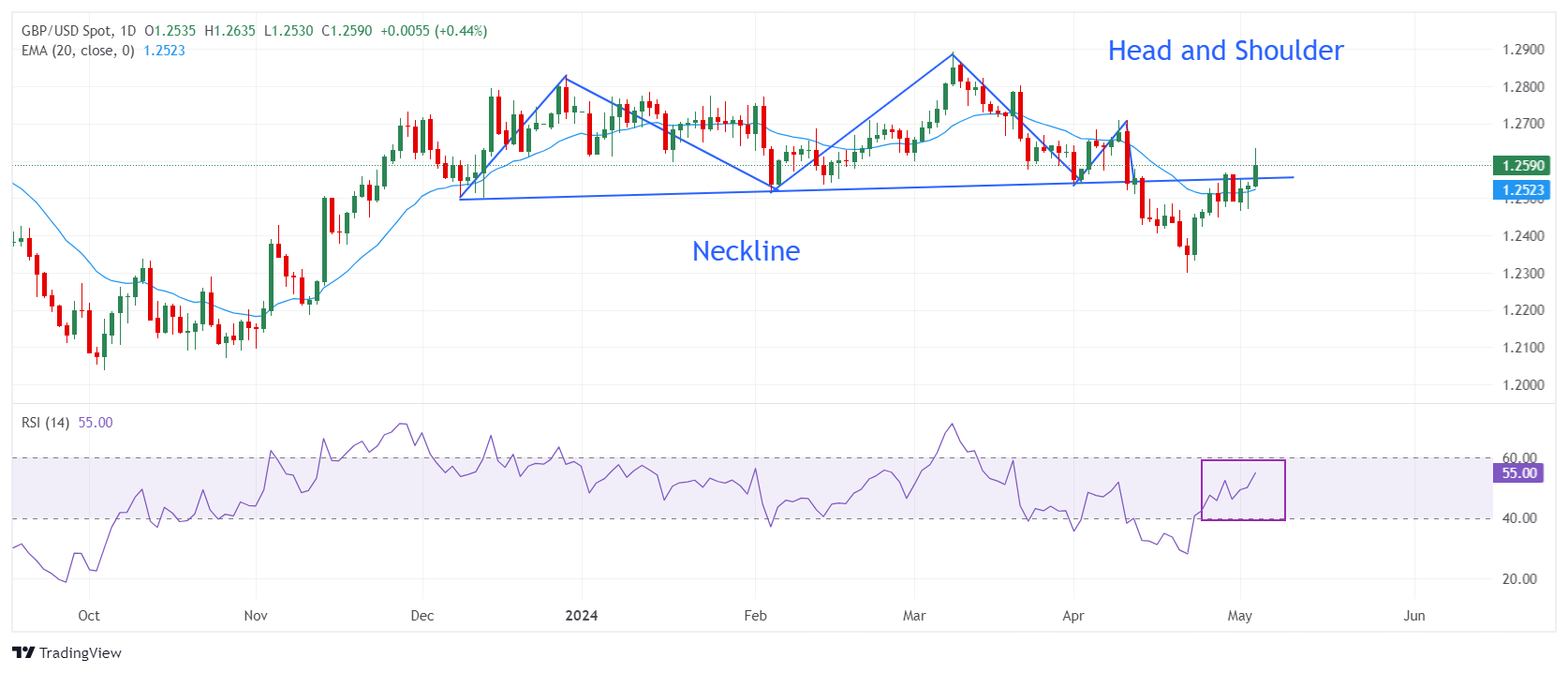- The British Pound recovers above 1.2600 amid improving market sentiment and a falling US Dollar.
- Demand for labor remains weak and wage growth slowed in April, fueling speculation about a Fed interest rate cut in June and weighing on the US dollar.
- The BoE is expected to start cutting interest rates from the September meeting.
The British Pound (GBP) advances above the 1.2600 resistance against the US Dollar (USD) early in the American session. GBP/USD strengthens while the US dollar falls after the US April Non-Farm Payrolls (NFP) report showed labor demand was weak and wage growth slowed further than expected.
The US NFP report showed that non-farm employers hired 175,000 workers in April, below the consensus of 243,000 and the previous reading of 315,000, revised up from 303,000. The unemployment rate rises to 3.9% from 3.8% in March. The average hourly earnings data, which provides a fresh outlook for inflation, softened to 3.9% from estimates of 4.0% and the previous reading of 4.1% year-on-year. The monthly figures grew at a slower pace of 0.2%, which was expected to rise steadily by 0.3%.
Signs of easing labor market conditions will boost Federal Reserve (Fed) rate cut bets, currently anticipated for the September meeting. Meanwhile, investors await the release of the US ISM Services Purchasing Managers' Index (PMI) for April, which will be released at 14:00 GMT. The services PMI, which represents the services sector that makes up two-thirds of the economy, is expected to rise to 52.0 from 51.4 in March.
Daily summary of market movements: Sterling rises while the US dollar trades around its three-week low
- The British Pound extends its recovery above 1.2600 against the US Dollar as market sentiment improves further following the release of weak US NFP data. The report showed that labor demand proved poor and wage growth softened in April. S&P 500 futures have posted stellar gains ahead of the US open, suggesting greater investor risk appetite.
- The US Dollar Index (DXY) hit a new three-week low around 104.50, weighed down by easing labor market conditions combined with weak first-quarter non-farm productivity data and Fed guidance on interest rates less aggressive than feared. First-quarter non-farm productivity data, which reflects hourly output per worker, grew at a significantly slower pace of 0.3%, versus expectations of 0.8% and a strong reading of 3.5% in the final quarter of 2023.
- On Wednesday, investors noted that the Fed remains leaning toward easing tightening this year after listening to Fed Chair Jerome Powell's monetary policy statement and press conference. Jerome Powell acknowledged that progress on disinflation has stalled, but he remains hopeful that rate cuts will be eventual this year. The Fed also slowed the pace of balance sheet reduction. The Fed said that starting June 1, it will reduce the cap on Treasury securities it allows to mature and not be replaced to $25 billion, from its current cap of up to $60 billion a month, Reuters reported.
- Apart from the cheerful mood in the markets, expectations that the Bank of England (BoE) will start reducing interest rates later than expected has also strengthened the GBP/USD pair. Financial markets see the BoE reducing interest rates from the September meeting, more or less in line with expectations that the US Federal Reserve will make a similar move. Previously, investors were divided between the June meeting or the August one.
- Speculation about the BoE's pivot to lower interest rates has been postponed as investors remain concerned about strong wage growth in the UK, which is fueling the underlying Consumer Price Index (CPI). , the central bank's preferred measure of inflation.
- Regarding general inflation, BoE Governor Andrew Bailey expressed confidence that it will return to the desired rate of 2%. The BoE's next monetary policy decision will be announced on May 9, and markets expect the bank to keep interest rates steady at 5.25%. Investors will be closely watching whether Andrew Bailey sticks to his statement that expectations of two or three rate cuts are reasonable this year, as he stated at the March policy meeting.
Technical Analysis: British Pound Extends Winning Streak and Jumps to 1.2600

The British pound extends its winning streak for the third day in a row. The GBP/USD pair remains above the psychological support of 1.2500. The short-term outlook for the Pound is bullish as it remains above the 20-day EMA, which is trading around 1.2520.
The pair breaks above the neck line of the head and shoulders pattern. On April 12, the pair experienced a sharp decline after breaking below the neck line of the H&S pattern drawn from the December 8 low around 1.2500.
The 14-period RSI is oscillating in the 40.00-60.00 range, suggesting indecision among market participants.
Nonfarm Payrolls FAQ
What are non-farm payrolls?
Non-farm payrolls (NFP) are part of the monthly employment report from the US Bureau of Labor Statistics. The non-farm payrolls component specifically measures the change in the number of people employed in the US during the previous month, excluding the agricultural sector.
How do nonfarm payrolls influence the Federal Reserve's monetary policy decisions?
The nonfarm payrolls figure can influence Federal Reserve decisions by providing a measure of how successfully the Fed is fulfilling its mandate of promoting full employment and 2% inflation.
A relatively high nonfarm payroll figure means that more people are employed, earning more money, and therefore likely spending more. Conversely, a relatively low nonfarm payrolls result could mean that people have difficulty finding work.
The Federal Reserve typically raises interest rates to combat high inflation caused by low unemployment, and lowers them to stimulate a stagnant labor market.
How do non-farm payrolls affect the US dollar?
Non-farm payrolls typically have a positive correlation with the US Dollar. This means that when payroll numbers are higher than expected, the Dollar tends to rise and vice versa when they are lower.
The NFP influences the US Dollar through its impact on inflation, monetary policy expectations, and interest rates. A higher NFP usually means that the Federal Reserve will be tighter in its monetary policy, which supports the USD.
How do non-farm payrolls affect the price of Gold?
Non-farm payrolls usually have a negative correlation with the price of Gold. This means that a higher than expected payroll figure will have a depressive effect on the price of Gold and vice versa.
A higher NFP usually has a positive effect on the value of the USD, and like most major commodities, Gold is priced in US Dollars. Therefore, if the USD gains value, fewer Dollars are needed to buy an ounce of Gold.
Furthermore, higher interest rates (usually aided by a higher NFP) also reduce the attractiveness of Gold as an investment compared to staying in cash, where the money will at least earn interest.
Sometimes nonfarm payrolls provoke a reaction opposite to what the market expects. For what is this?
Nonfarm payrolls are just one component within a larger employment report and can be overshadowed by the other components.
Sometimes, when nonfarm payrolls beat forecasts but average weekly earnings are lower than expected, the market has ignored the potentially inflationary effect of the headline result and interpreted the drop in earnings as deflationary.
The Participation Rate and Average Weekly Hours components can also influence the market reaction, but only on rare occasions, such as in the “Great Resignation” or the Global Financial Crisis.
Source: Fx Street
I am Joshua Winder, a senior-level journalist and editor at World Stock Market. I specialize in covering news related to the stock market and economic trends. With more than 8 years of experience in this field, I have become an expert in financial reporting.







